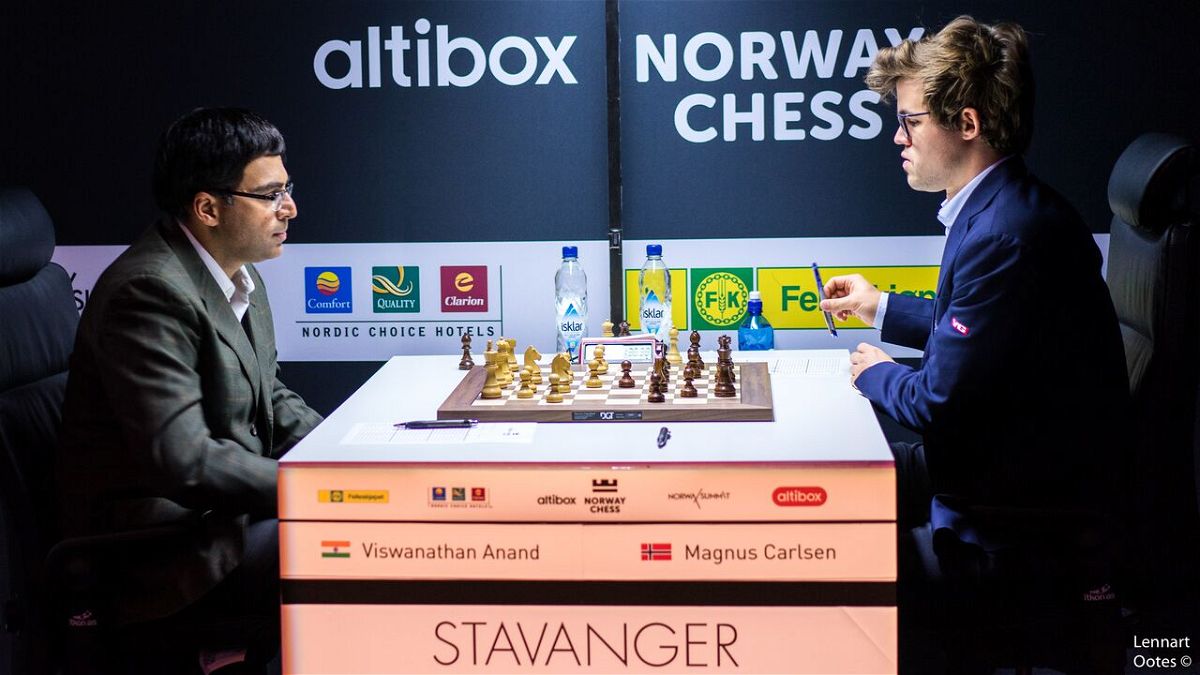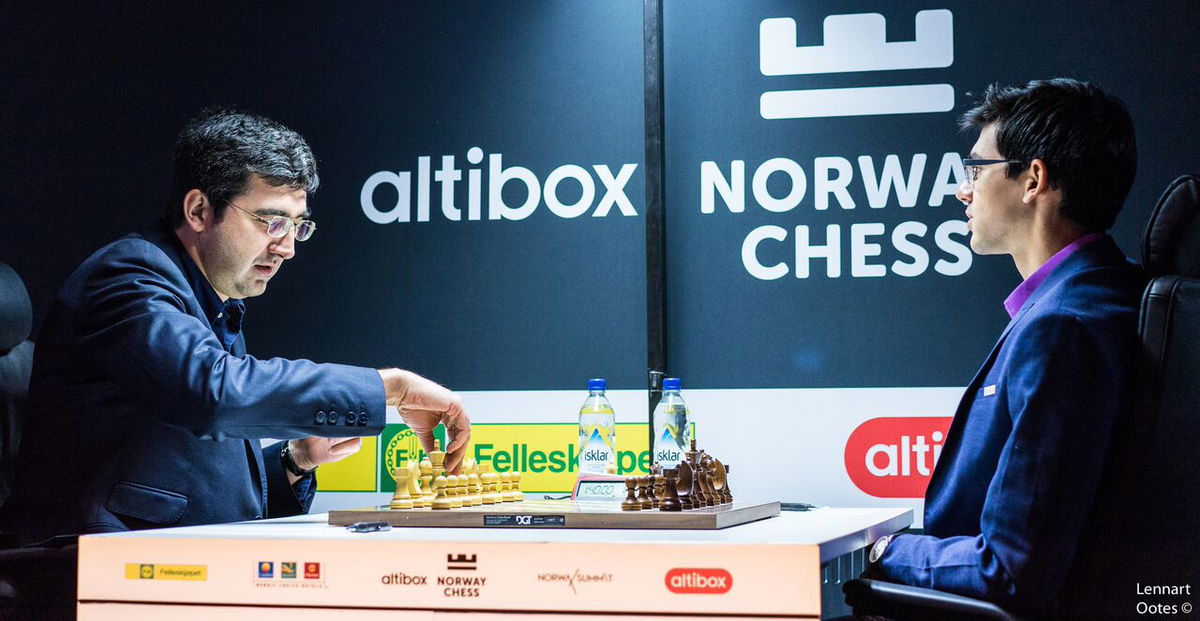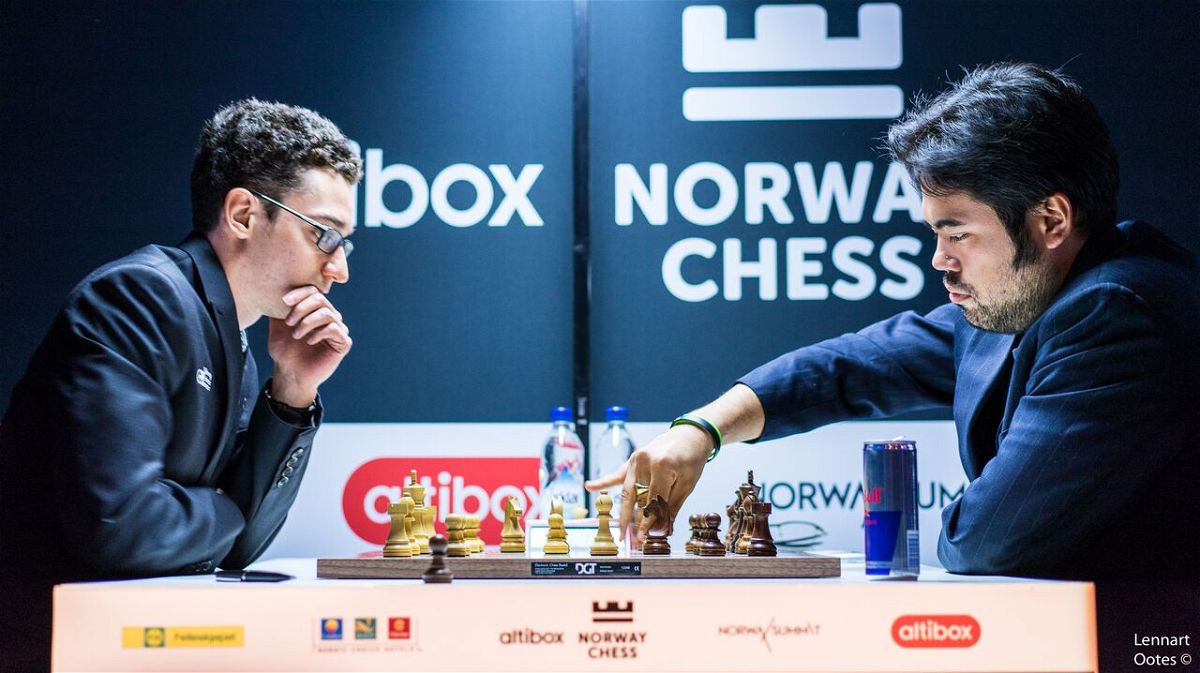Norway R09: Levon Aronian wins the tournament; Anand finishes with 4.0/9
The strongest tournament of the year 2017, Norway Chess came to an end. Levon Aronian displayed some fantastic chess to not only win the tournament, but also gain 16 Elo points and propel himself to world number four. Anand had to be content with the eighth spot with 4.0/9. Perhaps, this was one of the worst tournament for World Champion Magnus Carlsen who finished ninth. Aditya Pai, who has been covering this tournament intensively right from day one, brings you the final round report along with analysis by GM Alexander Yermolinsky.
Photos by Lennart Ootes and analysis by GM Yermolinsky

The strongest tournament of the year, Altibox Norway Chess, witnessed a spectacular finale yesterday evening. The battle for the title prize was mainly between the tournament leader, Levon Aronian and Hikaru Nakamura, who was just half a point behind him. However, the rest of the players were not at ease either. While the tail-enders wanted to improve their standing in the tournament, the ones in the middle of the table would have loved to finish a place or two above their current position. After all, there was a prize-fund of € 249, 000 on the line. And at the end of nine grueling rounds, it was Levon Aronian who emerged on top of the field that included eight out of the world’s top ten players.

Talking about his tournament win, Aronian said he feels the general level of his games was good. This is his second major win this year. The last one came at the Grenke Chess Classic in Baden-Baden, Germany where he won with a round to spare. When asked if this run of form makes him think again in terms of winning the World Championship, Aronian said, “I’d never stopped thinking about winning the World Championship. The day I stop thinking about it would either be the day I quit playing chess or the day when I finally become the World Champion.” He further said that despite all of the disappointments he had faced in the past, he’s taken them as temporary setbacks and moved forward with undeterred enthusiasm.
All players fought valiantly in the final round and two out of the five games ended with a decisive result. Fabiano Caruana, who had not won a single game at this event so far, was able to bring his countryman, Hikaru Nakamura, to his knees. Hikaru was the only player who had a chance to catch Levon Aronian in the lead. But since that didn’t happen, the Armenian super-star’s draw against Wesley So was enough to seal his first place.
Anand drew against Carlsen and the game between Sergey Karjakin and Maxime Vachier-Lagrave also ended peacefully after 30 moves. Vladimir Kramnik played the best game of the day probably and beat Anish Giri in just 20 moves!

The five-time World Champion from India, Vishy Anand, had the white pieces against the current World Champion, Magnus Carlsen. With a score of 3.5/8 each, both players had had quite a modest result in the tournament so far. A win would at least bring one of them to a 50% score. Also, Magnus, after hungrily hunting his first win of the tournament, had finally succeeded in the previous round. He must definitely have been in high spirits and could have been expected to try pressing for an advantage, even though he had the black pieces. It was Anand, however, who got an edge out of the opening but the game ended in a draw after 32 moves.
Anand once again deployed his apparently favorite opening of this tournament, the Italian, in his game against Carlsen. During the game, Anand thought that he had an edge and even Magnus agreed with this assessment. However, as the game progressed, both players were surprised by the amount of counter-play Black had in the position. After the game, Anand said maybe he rushed a bit with his move 20. Ra6 and that he should probably have played with some more subtlety. Nevertheless, he felt that Black had a solid position. Further, he said that he found the position after black’s 22…Nf7 a bit annoying because then Carlsen was able to at least swap a pair of knights and even if he won a pawn somewhere, it wouldn’t have been enough to win. And that’s exactly what happened later. Carlsen sacrificed a pawn and was able to exchange not one but both pairs of knights.
In the resulting position, even though Anand had an extra pawn, he chose to repeat the position and hold a draw because of the activity of Black’s major pieces. About his performance in the tournament, Anand said that he was satisfied with his performance in the second half of the tournament but overall the result was slightly disappointing. Talking to Nigel Short, he said, “Obviously, one doesn’t dream of (scoring) -1. But I had a bad start; and under the circumstances and in this kind of a tournament, it was a reasonable recovery. +1 in the last five games is fine. But I shouldn’t keep starting with -2,” (laughs).
[Site "Stavanger"]
[Date "2017.06.16"]
[Round "9"]
[White "Anand, Viswanathan"]
[Black "Carlsen, Magnus"]
[Result "1/2-1/2"]
[ECO "C54"]
[WhiteElo "2786"]
[BlackElo "2832"]
[Annotator "Alex Yermolinsky"]
[PlyCount "67"]
[EventDate "2017.??.??"]
O-O 9. h3 h6 10. Nbd2 Be6 11. Bxe6 fxe6 12. b4 Nh5 13. Ra2 Qf6 14. Nc4 {
[#] This Italian Guoco Piano/Anti-Berlin Ruy Lopez is a staple of top level
chess these days. Between the two of them Anand and Carlsen must have played
it a hundred times, including many battles against each other.} b5 $6 {I don't
particularly like this move and I suspect Magnus didn't much fancy it either.}
({The thing is, the normal} 14... Ne7 {allows} 15. d4 $1 {and even if Black
can hold his own after} exd4 16. cxd4 Ng6 17. e5 $1 Qf5 {which is not a fact
yet, the position after} 18. exd6 Qd5 19. Rc2 cxd6 {offers White a chance to
wrap it up with repetition:} 20. Ne3 Qe4 21. Nc4) 15. Ne3 ({White has to be a
bit careful not to walk into} 15. axb5 axb5 16. Ne3 $2 Bxe3 17. Rxa8 Bxf2+)
15... Bb6 16. Ng4 Qe7 17. Be3 Bxe3 18. fxe3 {In the resulted symmetrical
structure White holds two advantages: pressure against b5 and better posts for
his knights. Granted, it's not much yet, but White's prospects look much
brighter.} Rab8 {Concession no.1} 19. axb5 axb5 20. Ra6 Nd8 {Concession no.2
of the same} 21. d4 exd4 22. cxd4 Nf7 {[#]} 23. Qc2 $2 {Not a bad move in
itself, but I mark it down for a missed opportunity.} (23. e5 $1 Ng3 24. Qc2
Nf5 (24... Ng5 {offers no compensation whatsoever:} 25. Nxg5 Qxg5 26. exd6 cxd6
27. Rxd6 h5 28. Ne5 $16) 25. e4 Ng3 (25... Nh4 26. Nf6+ gxf6 27. Nxh4 Kg7 28.
exd6 cxd6 29. d5 {is disastrous for Black.}) 26. Rc6 {would put Magnus on the
ropes yet again. We are used to his indifference to playing for an opening
advantage with white because we know of his ability to win from equal
positions. Getting in trouble with black, as it consistently happened to
Carlsen in this tournament, is another kettle of fish.}) 23... Nf6 $1 {At the
last moment the hapless knight escapes.} 24. Nxf6+ Qxf6 25. Rc6 Ng5 $1 {
Now Carlsen has a clear path to counterplay.} 26. Nxg5 Qxg5 27. Rxc7 Qg3 $1 28.
Qe2 ({Still,} 28. Re2 Ra8 29. Qc1 Ra4 30. Qe1 {was worth trying.}) 28... Ra8
29. Rcc1 Ra3 30. Ra1 Rb3 31. Rab1 Ra3 32. Ra1 Rb3 33. Rab1 Ra3 34. Ra1 1/2-1/2
Magnus Carlsen, who attended a press conference with the official commentators for the first time after his loss in round 4, explained his tournament result saying that although the first two rounds went okay for him, he wasn’t feeling fresh in his head in his game against Nakamura in the third round. This trend continued in the subsequent rounds as well. He felt, the worst point of the tournament for him was during the fifth and the sixth rounds when he couldn’t make anything of his whites. He further said that he not only played poorly but he also lacked motivation. And in the end it was the lack of confidence from the start along with some good play by his opponents that led to his downfall. Magnus also explained his choice of number during the drawing of lots saying it wasn’t because he wanted to play Wesley So in round 1 that he chose the number 3. It was more because he wanted whites in the fifth and the sixth rounds.


Kicking off with an unusual Queen’s Pawn opening, Vladimir Kramnik came back strongly after last round’s defeat by beating Anish Giri. Talking about the game, Giri said he thought Kramnik’s 8. Nc3 was pretty dubious and he wanted to punish this. And given his advantage in space and the miserable position of Kramnik’s dark squared bishop, it really did look like things could end up badly for Big Vlad. But by the twelfth move, Giri admitted that he thought he was close to being completely lost. Giving his thoughts about the game, Kramnik said he felt that the position arising after black’s fifth move, 5…c4, was very complicated and he never thought anyone would play it.
After the game, both players agreed that Giri made the most critical mistake of the game when he played 9…Bd6 instead of bringing his knight out to c6. Another crucial mistake from Giri was 15…g6 which allowed Kramnik to free his pieces at the cost of a pawn. Just three moves after this, Kramnik had a completely winning position and Giri had to resign in merely 20 moves.
[Site "Stavanger"]
[Date "2017.06.16"]
[Round "9"]
[White "Kramnik, Vladimir"]
[Black "Giri, Anish"]
[Result "1-0"]
[ECO "D05"]
[WhiteElo "2808"]
[BlackElo "2771"]
[Annotator "Alex Yermolinsky"]
[PlyCount "39"]
[EventDate "2017.??.??"]
that has a lot of ambition behind it. Black goes for space at the cost of
relieving pressure against the d4-pawn.} 6. Be2 b5 7. b3 Bb7 8. Nc3 $6 {
A provocative reply from Vladimir.} (8. a4 a6 9. c3 Nbd7 10. Nbd2 Be7 11. Ba3
O-O 12. Qc2 {was Kuraica-Bareev, 2003 which ended in an upset win by the
Bosnian veteran.}) 8... b4 {Anish doesn't hesitate to go for a space grab.} ({
Rakhmanov-Vallejo Pons, 2013 saw a more subtly approach by Black:} 8... a6 9.
Ne5 (9. bxc4 dxc4 $1) 9... Qc7 10. Bd2 Nc6 11. f4 Bd6 12. Bf3 Ne7 13. Rb1 {
and only now} b4 $1 {[#] Here White missed his last chance to make a game out
of his dubious setup.} 14. Nxd5 $5 exd5 15. bxc4 a5 $1 (15... dxc4 16. Bxb7
Qxb7 17. Nxc4 Qc7 18. Nxd6+ Qxd6 19. Bxb4 Qc6 20. Qd3 Qe4 21. f5 {White isn't
in such a bad way here.}) 16. a3 O-O 17. c5 Bxe5 18. fxe5 Ne4 19. axb4 axb4 20.
Rxb4 {but Black is probably better here.}) 9. Na4 c3 10. Ne5 {[#]} Bd6 $2 ({
The correct} 10... Nc6 11. a3 a5 12. Bb5 Qc7 {would practically compel White
to try the highly speculative} 13. e4 {because otherwise his Bc1 would have no
way out.} Nxe4 14. Qg4 h5 15. Qe2 Bd6 16. Be3 $15) 11. a3 ({Also,} 11. Bb5+ {
right away has its points.} Kf8 12. Nc5 Qb6 (12... Bxc5 {is depressing. After}
13. dxc5 Qa5 14. a4 Qc7 15. Qd4 {White has full control of the dark squares.})
13. Nxb7 Qxb7 14. Qd3 a6 15. Ba4 {How does Black develop here? It won't take
White long to prepare e3-e4.}) 11... a5 (11... O-O {would be a major
concession. White simply goes} 12. axb4 Bxb4 13. Ba3 a5 14. Nc5 Qc7 15. Bxb4
axb4 16. Rxa8 Bxa8 17. Qd3 Nc6 18. f4 {and he has all the play on the a-file
and against the weak b4-pawn. That's the problem with attempting to grab space:
it only works when we get to push his pieces back. Once the opponent finds his
way around the advancing pawns (Na4-c5 in this case), they become terribly
weak.}) 12. Bb5+ Kf8 ({Same story unfolds in case of} 12... Nbd7 13. Nxd7 Nxd7
14. Nc5 Bxc5 15. dxc5 Qc7 16. axb4 axb4 17. Rxa8+ Bxa8 18. Qd4 O-O 19. Bxd7
Qxd7 20. Qxb4 $18) 13. Nc5 Qb6 14. Nxb7 Qxb7 15. Qe2 {[#] The black king is in
more trouble than it seems, and, of course, the black rooks aren't coordinated.
} g6 {One of those "positional" moves that at times can meet with a direct
tactical refutation.} (15... h5 16. f3 h4 17. e4 Qb6 18. Kh1 Qxd4 19. Bf4 {
is quite dangerous for Black, yet, it seemed a better choice.}) 16. e4 Nxe4 (
16... dxe4 17. Bh6+ Kg8 18. axb4 Bxb4 19. f3) (16... Kg7 17. Nxf7 $1 {Perhaps,
Anish missed that one.} Kxf7 18. e5 $18) 17. Bh6+ Ke7 (17... Kg8 18. Ng4 Be7
19. axb4 axb4 20. Rxa8 Qxa8 21. f3 Nf6 22. Qe5 $18) 18. f3 $18 {Black won't
last long here.} Nd2 ({Some spectacular lines Anish Giri decided to leave in
the dark:} 18... Bxe5 19. fxe4 Bxd4+ 20. Kh1 dxe4 21. Rad1 e5 22. Qc4) ({or}
18... Nf6 19. Rfe1 Bxe5 20. dxe5 Nfd7 21. axb4 axb4 22. Rxa8 Qxa8 23. Qf2 Qa5
24. Qh4+ Ke8 25. Qf6 Rg8 26. Bg5) 19. Rfe1 Kd8 20. Bf4 (20. Bf4 Kc7 21. axb4
axb4 22. Rxa8 Qxa8 23. Nxf7 Bxf4 24. Qxe6 Rc8 25. Qf6 $1) 1-0

In the other decisive game of the round, Fabiano Caruana was able to clinch his first win by beating his countryman Hikaru Nakamura. Desperate for a win in order to catch Aronian in the lead, Nakamura went for the razor sharp Najdorf variation of the Sicilian Defense. As play proceeded, the game drifted into the waters of the poisoned pawn line where Caruana went for 8. Qd3, a line which he said he used to play when he was a kid. Interestingly, he also pointed out that Black has at least seven different ways to draw the game after white’s 8. Qd3. Of course, Nakamura wasn’t going to go for one of those given that he needed a win.
As play proceeded, Caruana came up with a novelty on his 15th move and said it was fortunate that Nakamura wasn’t aware of the move. On move 20, Naka was forced to exchange queens and placed his knight passively to hold his position together. But Caruana kept playing energetically and on move 39, Nakamura was forced to give up his rook for white’s bishop to parry Caruana’s mating threats. And although Nakamura limped on until the 59th move, the result was never really in doubt after Caruana had won the exchange.
[Site "Stavanger"]
[Date "2017.06.16"]
[Round "9"]
[White "Caruana, Fabiano"]
[Black "Nakamura, Hikaru"]
[Result "1-0"]
[ECO "B97"]
[WhiteElo "2808"]
[BlackElo "2785"]
[Annotator "Alex Yermolinsky"]
[PlyCount "117"]
[EventDate "2017.??.??"]
Qxb2 9. Rb1 Qa3 10. f5 Be7 11. fxe6 fxe6 12. Be2 Qa5 13. Bd2 Qc7 14. g4 h6 {
[#] Lots of theory here, in this modern take on the Poisoned Pawn.} 15. Rg1 {
Caruana seeks his own way.} ({The originators of the whole line, the Azeri
stars Radjabov, Gashimov and Mamedov, split their efforts between} 15. Qh3) ({
and} 15. e5) 15... Bd7 16. g5 hxg5 17. Rxg5 Nc6 {Hikaru decides to gives back
the pawn right away. By doing this he utilizes a common approach of
sidestepping the bulk of opponent's preparation. The drawback is in settling
for an inferior move.} ({I'm sure Fabi had some home cooking ready for} 17...
Rh7 {but likely, it was not} 18. e5 dxe5 19. Ne4 $2 Nxe4 20. Qxe4 Bxg5 21. Qxh7
Bxd2+ 22. Kxd2 Qa5+ 23. Kd1 Qd5 $17) 18. Rxg7 O-O-O (18... Nxd4 19. Qxd4 {
and Black cannot castle.}) 19. Ncb5 $1 axb5 20. Nxb5 Ne5 $1 (20... Qb8 {
gets trashed by} 21. Rxe7 Nxe7 22. Nxd6+ Kc7 23. Bf4) 21. Nxc7 Nxd3+ 22. cxd3 {
[#]} Ng8 $2 ({The redemption could only be found in an incredible
computer-generated idea:} 22... Rxh2 $3 23. Rxe7 Rh1+ 24. Bf1 Rf8 {and Black
wins his piece back.}) 23. Na8 ({Also,} 23. Ba5 Rxh2 24. Kd2 {was quite good
for White.}) 23... Kb8 24. Nb6 Bc6 25. Bf4 {In the immortal words of Roman
Dzindzi, White has the pawn and the compensation.} e5 26. Bg3 Bf6 27. Rf7 Be8
28. Rf8 Bg7 29. Rf2 Ne7 30. Bg4 Nc6 31. Rfb2 Nd4 32. Nd5 b5 33. a4 Bh6 34. axb5
Rg8 35. h3 Kb7 36. Ne7 Rf8 37. Nc6 $1 {The shortest way to victory.} Bxc6 38.
bxc6+ Kxc6 39. Bf2 {[#]Now White threatens to eliminate Nd4 with checkmate to
follow. Hikaru had no choice, but he knew it wasn't going to be enough.} Rxf2
40. Kxf2 Rf8+ 41. Kg2 Be3 42. Rb8 Rxb8 43. Rxb8 d5 44. Rc8+ Kd6 45. Rd8+ Ke7
46. Rd7+ Kf6 47. exd5 e4 48. dxe4 Bf4 49. h4 Nb5 50. h5 Be5 51. Bf5 Kg5 52. Bg6
Nd6 53. Re7 Nc4 54. Re6 Bf6 55. d6 Ne5 56. Bf5 Nd3 57. Rxf6 Kxf6 58. d7 Ke7 59.
h6 1-0
In the final standings, Aronian, with a score of 6.0/9, finished as the title prize winner. Kramnik, with his fantastic win against Giri made it to join Nakamura and share second place. Both of them scored 5.0/9. Caruana, Giri and Wesley So shared the third place with a score of 4.5/9. Anand, with a score of 4.0/9 secured the fourth spot along with Maxime Vachier-Lagrave and Magnus Carlsen. Sergey Karjakin finished at the bottom of the leaderboard with 3.5/9.

Replay all the games:
Coverage on Firstpost:
Firstpost and ChessBase India have collaborated to bring you extensive and detailed coverage of the chess scene in India and internationally.

R1: Altibox Norway Chess: Viswanathan Anand should be buoyed by draw with black pieces in 1st round
R2: Altibox Norway Chess: Viswanathan Anand hurt by misjudgment against Vladimir Kramnik in 2nd round
R3: Viswanathan Anand up to the task as Sergey Karjakin tests his memory, preparation
R4: Altibox Norway Chess: Viswanathan Anand's position grim after 2nd loss, but can't count him out yet
R6: Altibox Norway Chess: Viswanathan Anand shows he is far from 'over' with Round 6 comeback
R7: Altibox Norway Chess: Viswanathan Anand's prospects fade after Round 7 draw
R8: Altibox Norway Chess: Viswanathan Anand draws Round 8 tie; Magnus Carlsen retains World No 1 spot
